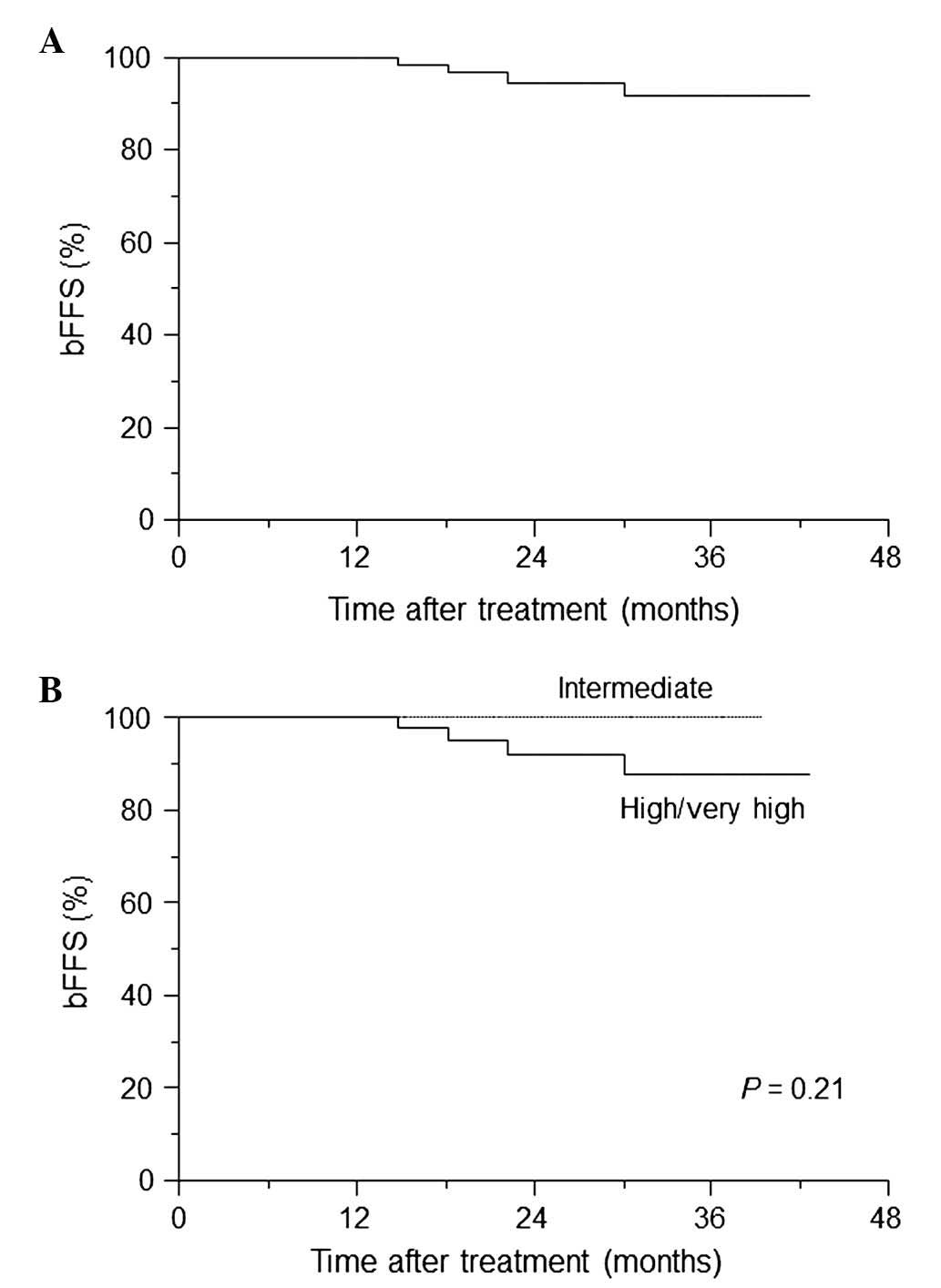|
1
|
Crook J: The role of brachytherapy in the
definitive management of prostate cancer. Cancer Radiother.
15:230–237. 2011. View Article : Google Scholar : PubMed/NCBI
|
|
2
|
Ghilezan M: Role of high dose rate
brachytherapy in the treatment of prostate cancer. Cancer
Radiother. 16:418–422. 2012. View Article : Google Scholar : PubMed/NCBI
|
|
3
|
Hoskin PJ, Colombo A, Henry A, Niehoff P,
Hellebust Paulsen T, Siebert FA and Kovacs G: GEC/ESTRO
recommendations on high dose rate afterloading brachytherapy for
localised prostate cancer: An update. Radiother Oncol. 107:325–332.
2013. View Article : Google Scholar : PubMed/NCBI
|
|
4
|
Hoskin PJ, Rojas AM, Bownes PJ, Lowe GJ,
Ostler PJ and Bryant L: Randomised trial of external beam
radiotherapy alone or combined with high-dose-rate brachytherapy
boost for localised prostate cancer. Radiother Oncol. 103:217–222.
2012. View Article : Google Scholar : PubMed/NCBI
|
|
5
|
Langley S, Laing R, Henderson A, Aaltomaa
S, Kataja V, Palmgren JE, Bladou F, Salem N, Serment G, Nava L, et
al: European collaborative group on prostate brachytherapy:
Preliminary report in 1175 patients. Eur Urol. 46:565–570;
discussion 570. 2004. View Article : Google Scholar : PubMed/NCBI
|
|
6
|
Zwahlen DR, Andrianopoulos N, Matheson B,
Duchesne GM and Millar JL: High-dose-rate brachytherapy in
combination with conformal external beam radiotherapy in the
treatment of prostate cancer. Brachytherapy. 9:27–35. 2010.
View Article : Google Scholar : PubMed/NCBI
|
|
7
|
Demanes DJ and Ghilezan MI: High-dose-rate
brachytherapy as monotherapy for prostate cancer. Brachytherapy.
13:529–541. 2014. View Article : Google Scholar : PubMed/NCBI
|
|
8
|
Roach M III, Hanks G, Thames H Jr,
Schellhammer P, Shipley WU, Sokol GH and Sandler H: Defining
biochemical failure following radiotherapy with or without hormonal
therapy in men with clinically localized prostate cancer:
Recommendations of the RTOG-ASTRO Phoenix Consensus Conference. Int
J Radiat Oncol Biol Phys. 65:965–974. 2006. View Article : Google Scholar : PubMed/NCBI
|
|
9
|
Kovács G, Galalae R, Loch T, Bertermann H,
Kohr P, Schneider R and Kimming B: Prostate preservation by
combined external beam and HDR brachytherapy in nodal negative
prostate cancer. Strahlenther Onkol. 175(Suppl 2): S87–S88. 1999.
View Article : Google Scholar
|
|
10
|
Yoshioka Y, Nose T, Yoshida K and Inoue T,
Yamazaki H, Tanaka E, Shiomi H, Imai A, Nakamura S, Shimamoto S and
Inoue T: High-dose-rate interstitial brachytherapy as a monotherapy
for localized prostate cancer: Treatment description and
preliminary results of a phase I/II clinical trial. Int J Radiat
Oncol Biol Phys. 48:675–681. 2000. View Article : Google Scholar : PubMed/NCBI
|
|
11
|
Ghilezan M, Martinez A, Gustason G, Krauss
D, Antonucci JV, Chen P, Fontanesi J, Wallace M, Ye H, Casey A, et
al: High-dose-rate brachytherapy as monotherapy delivered in two
fractions within one day for favorable/intermediate-risk prostate
cancer: Preliminary toxicity data. Int J Radiat Oncol Biol Phys.
83:927–932. 2012. View Article : Google Scholar : PubMed/NCBI
|
|
12
|
Anderson JF, Swanson DA, Levy LB, Kuban
DA, Lee AK, Kudchadker R, Phan J, Bruno T and Frank SJ: Urinary
side effects and complications after permanent prostate
brachytherapy: The MD Anderson cancer center experience. Urology.
74:601–605. 2009. View Article : Google Scholar : PubMed/NCBI
|
|
13
|
Crook J, Fleshner N, Roberts C and Pond G:
Long-term urinary sequelae following 125 iodine prostate
brachytherapy. J Urol. 179:141–145; discussion 146. 2008.
View Article : Google Scholar : PubMed/NCBI
|
|
14
|
Keyes M, Miller S, Moravan V, Pickles T,
McKenzie M, Pai H, Liu M, Kwan W, Agranovich A, Spadinger I, et al:
Predictive factors for acute and late urinary toxicity after
permanent prostate brachytherapy: Long-term outcome in 712
consecutive patients. Int J Radiat Oncol Biol Phys. 73:1023–1032.
2009. View Article : Google Scholar : PubMed/NCBI
|
|
15
|
Merrick GS, Butler WM, Wallner KE,
Galbreath RW, Allen ZA, Gutman S and Lief J: Long-term rectal
function after permanent prostate brachytherapy. Cancer J.
13:95–104. 2007. View Article : Google Scholar : PubMed/NCBI
|
|
16
|
Zelefsky MJ, Hollister T, Raben A,
Matthews S and Wallner KE: Five-year biochemical outcome and
toxicity with transperineal CT-planned permanent I-125 prostate
implantation for patients with localized prostate cancer. Int J
Radiat Oncol Biol Phys. 47:1261–1266. 2000. View Article : Google Scholar : PubMed/NCBI
|
|
17
|
Zamboglou N, Tselis N, Baltas D, Buhleier
T, Martin T, Milickovic N, Papaioannou S, Ackermann H and Tunn UW:
High-dose-rate interstitial brachytherapy as monotherapy for
clinically localized prostate cancer: Treatment evolution and
mature results. Int J Radiat Oncol Biol Phys. 85:672–678. 2013.
View Article : Google Scholar : PubMed/NCBI
|
|
18
|
Yoshioka Y, Konishi K, Sumida I, Takahashi
Y, Isohashi F, Ogata T, Koizumi M, Yamazaki H, Nonomura N, Okuyama
A and Inoue T: Monotherapeutic high-dose-rate brachytherapy for
prostate cancer: Five-year results of an extreme hypofractionation
regimen with 54 Gy in nine fractions. Int J Radiat Oncol Biol Phys.
80:469–475. 2011. View Article : Google Scholar : PubMed/NCBI
|
|
19
|
Yoshioka Y, Nose T, Yoshida K, Oh RJ,
Yamada Y, Tanaka E, Yamazaki H and Inoue T and Inoue T:
High-dose-rate brachytherapy as monotherapy for localized prostate
cancer: A retrospective analysis with special focus on tolerance
and chronic toxicity. Int J Radiat Oncol Biol Phys. 56:213–220.
2003. View Article : Google Scholar : PubMed/NCBI
|
|
20
|
Yamada Y, Rogers L, Demanes DJ, Morton G,
Prestidge BR, Pouliot J, Cohen GN, Zaider M, Ghilezan M and Hsu IC:
American Brachytherapy Society: American brachytherapy society
consensus guidelines for high-dose-rate prostate brachytherapy.
Brachytherapy. 11:20–32. 2012. View Article : Google Scholar : PubMed/NCBI
|
|
21
|
Yoshioka Y, Konishi K, Suzuki O, Nakai Y,
Isohashi F, Seo Y, Otani Y, Koizumi M, Yoshida K, Yamazaki H, et
al: Monotherapeutic high-dose-rate brachytherapy for prostate
cancer: A dose reduction trial. Radiother Oncol. 110:114–119. 2014.
View Article : Google Scholar : PubMed/NCBI
|















